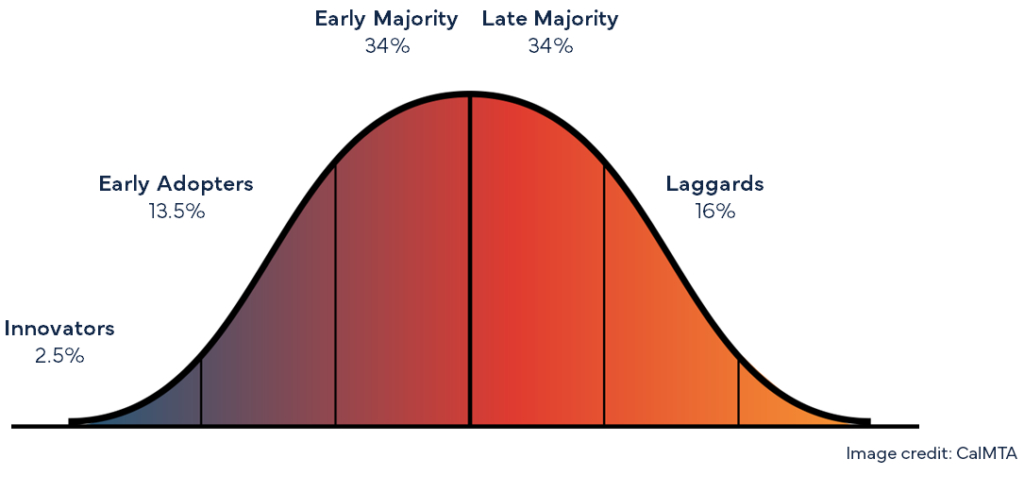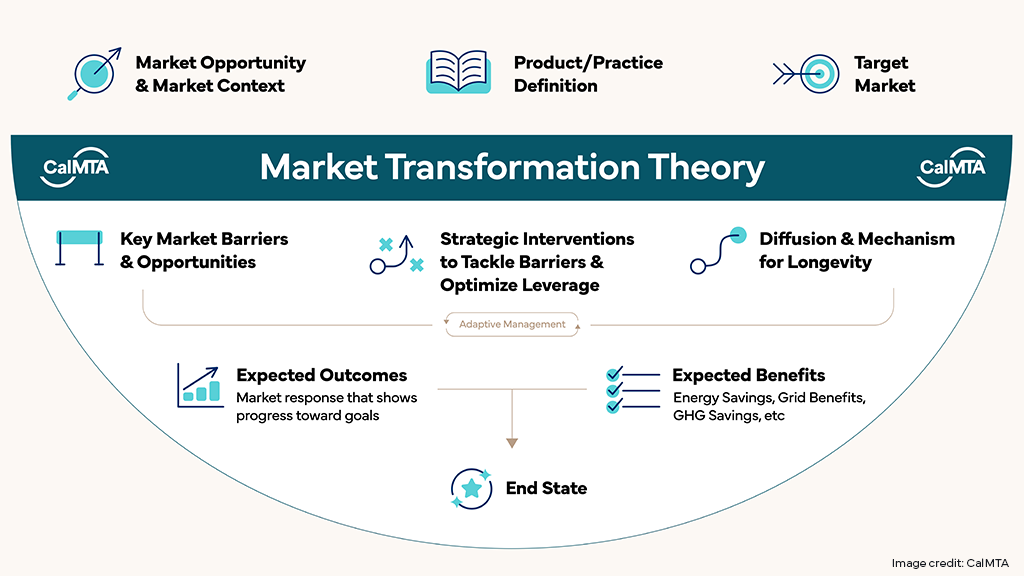

Our Work
Market transformation is a proven strategic process of intervening in a market to create lasting change.
Market transformation is a proven strategic process of intervening in a market to create lasting change. In the context of CalMTA’s work, these changes work to deliver cost-effective energy efficiency and support California’s other goals on greenhouse gas (GHG) reduction, workforce development, and equity.
 The purpose of market transformation programs is to accelerate diffusion — or market share — of the desired energy-efficient technology or practice. Diffusion is the process by which market adoption spreads over time across consumer groups of innovators and early adopters to a tipping point of acceptance. The diffusion of innovation curve that illustrates this concept (see graph above) was developed by E.M. Rogers.
The purpose of market transformation programs is to accelerate diffusion — or market share — of the desired energy-efficient technology or practice. Diffusion is the process by which market adoption spreads over time across consumer groups of innovators and early adopters to a tipping point of acceptance. The diffusion of innovation curve that illustrates this concept (see graph above) was developed by E.M. Rogers.
By reducing barriers to the adoption of specific energy-efficient technologies or practices and capitalizing on market opportunities, a market transformation approach can yield measurable benefits that remain long after active market interventions have ended.
Anatomy of an MTI

The process of developing a market transformation initiative (MTI) begins with identifying the market opportunity & context for an energy efficiency technology or practice that is well-suited for a market-level intervention that will result in transformative change. We look for structural barriers preventing growth in market share to help identify market interventions that will have large-scale, long-term impact.
The CalMTA team refines the product or practice definition to target the specific technology or behavioral attributes that will be most responsive to strategic interventions and yield the highest-value benefits. Clearly defining the MTI target market allows us to focus on segments with the greatest potential for leverage and influence. Based on this refinement, we can then understand the opportunities for market adoption and a growth trajectory.
A market characterization informs development of a market transformation theory, which guides the MTI’s development and implementation, and centers on a logic model: a systemic and visual presentation of specific barriers and opportunities and how strategic interventions in the market would affect sustained change.
We also seek to exploit leverage at key points to create the changes that will allow the targeted product or practice to become a regular or even preferred offering.
Leverage points can include incentives offered by other programs, motivated market actors, voluntary regulatory requirements, or product ratings like the ENERGY STAR® label. MT theory also maps out the potential for market diffusion (increase in market adoption) and a mechanism for longevity of market changes.
As the MTI is deployed in the market and we begin to see the expected outcomes and benefits realized, we track our progress through independent third-party evaluation against established market progress indicators (MPIs). An adaptive management process allows us to respond to ongoing changes in the market landscape, the product or practice, and the target market, as well as what we learn through our metrics and data.
Evaluation findings also help us determine when barriers have been removed or reduced enough that the market will continue to transform without further intervention — in some cases, with the targeted technology or practice locked in as a code or standard. At that point, the MTI reaches its end state.